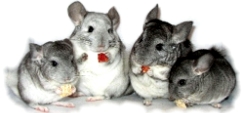Congrats on your new chinchilla. That is exciting.
A two hour drive is nothing. A small carrier is ideal. You may want to cover it with a blanket. Preferably one you don't care about because it may pull it through the bars and chew it (which you shouldn't let it do if you can prevent it). A healthy chinchilla is good for about 24 hours without food and water and probably won't eat in the carrier anyway. (However a chinchilla that does not eat for 24 hours because there is a health problem is to be considered an dire emergency and complications can occur afterwards without intervention).
For your trip the most dangerous thing is heat. Make sure to keep the carrier off of the hot floor of the car and try to keep the inside at 75F or below. Anything over 80F can be fatal for a chinchilla.
Here are some pointers:
Once you are home I recommend not to let your pet roam around outside of its cage. Make sure the cage is completely set up and try not to handle it very much for about a week. Do not give it treats during that time because it will be stressed and its digestion is going to be a little off. If you want to dust bathe it dust it in its cage. (Dust baths should be done with volcanic dust like Blue Cloud and not more often than 10 minutes at a time every other day to avoid health problems). Also during that time run a fan (don't blow it into the cage) but the noise will drown out other noises and help it adjust to its new place. (Out of any kind of direct sunlight, away from cats and dogs, and anything that may startle it)
Don't let it out of its big cage until it proves to you that it is not afraid of you. This can can take a week or two. It should come to you and allow you to touch it under its chin without running off like it is afraid. Interact with it through the door and through the bars daily. Chinchillas are usually shy animals and it takes a little time for them to bond and get used to you. Typically they do not like to be touched and handled and will have to be tamed. (Approaching from directly above or behind can cause panic so be careful) That is a slow process so please be patient. It is worth doing it right. Some chinchillas are tamer than others so learn how to read your pet's actions.
Please weigh your pet in the travel cage when you get home. (then subtract the weight of the cage) and weigh it once a week and keep logs. Sometimes weight logs are the only way to diagnose certain illnesses.
When transferring it out of the carrier if you must handle it make sure you have a good hold of it. You can support it by the base of the tail to help. A chinchilla can easily injure itself if it panics and starts flailing around. They can also slip their fur out where they are being held and become very slippery. Chins are extremely fast and if they get loose you'll have to chase and catch it which is a very bad thing for the bonding process. Otherwise set it up so your chinchilla can safely jump out of the carrier into the big cage on it own.
If there is anything else feel free to ask.

 Author
Topic: Traveling Chin (Read 1427 times)
Author
Topic: Traveling Chin (Read 1427 times)




